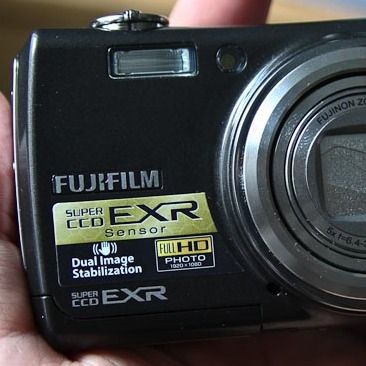With increasing megapixels not always getting the best results, camera companies are turning to other technologies to help you take better pictures. So can Fujifilm's latest EXR technology do the trick? We get snapping to find out.
Our quick take
This isn't the smallest camera out there, however the in-camera technology and features make this a very versatile camera indeed.
Turning the flash off did mean there is a tendency of the F200EXR over compensating to get the shot and pumping up the ISO. While this means you do get that image pretty much regardless of the situation, the results can be a little noisy.
The upshot to all this however, is that you've got the shot in the bag rather than a burred mess when you get home.
If you are looking for a camera that is compact and virtually guarantees you'll get a decent image at the end, this is certainly one to look closer at.
Taking a picture doesn't get much easier.

Fujifilm FinePix F200EXR digital camera - 4.0 / 5
| FOR | AGAINST |
|---|---|
|
|
The FinePix F200EXR is a 12-megapixel compact that offers a Fujinon 5x, 28-140mm wide angle optical zoom lens and a 3-inch 230,000 dot LCD.
This is no thin, slim, compact camera, but it's solidly built and not overly heavy, sitting comfortably in the hand. It will still fit in your pocket, just don't expect to not notice you've got it on you.
That 3-inch screen doesn't dominate the back as much as you might imagine and that means you've got plenty of space for an array of dials and buttons down the right hand side. You get buttons for everything including one dedicated to turning on/off face detection. The zoom control is found circling the shutter button.
The sides feature flaps for the battery housing and SD card slot, and USB out to connect it to your PC or TV via an all-powerful single cable.
Turn the camera on and there are plenty of customisation options as well as presets making this a perfect camera for growing into.
Out of the box you can just point and shoot your way into a photo album. The controls are easy to master and there are plenty of on-screen information cards to let you know what's going on and more importantly what those setting you've chosen will do to your picture.
The presets are handy, but it's easy enough to quickly move away from this if you wish and start tinkering. Those who've moved from film for the first time (are there really any of those people left?) can choose to have a film like quality added to the picture in-camera - there are five settings from PROVIA to Velvia to Astia to black and white, or sepia.
Then there is the usual array of face detection and image stabilisation technologies for example, sensitivity up to mind blowing ISO 12800 on 3-megapixel pics and intelligent flash so you aren't just blasting everything with light in the hope that it will make everything better.
But that isn’t why you are going to be buying this model. The reason is, is those three magic words at the end of the 200 - EXR.
While the camera has an Auto mode that promises to do everything for it, the chances are you'll be using the EXR mode that will let "the camera automatically optimize settings for your current subject, or to improve clarity, reduce noise, or enhance dynamic range".
Put simply the technology takes two pictures at the same time at different exposure settings and then merges them in an HDR (high dynamic range) style approach so you get rid of the overly bright elements or overly dark elements of a picture.
Within the EXR setting there are three further options beyond full Auto mode: resolution priority, high ISO and low noise, and D-range priority.
The first is to be used shooting subjects in detail, the second for reducing noise, while the third prevents washout and captures tonality in bright scenes, with the Auto mode choosing the best of the three for the situation at hand.
In practice and we've struggled to take a bad picture, which is clearly a good thing. Rather than merely take everything at 12 megapixels and be done with it, the camera works out what you are doing and adjusts accordingly. This normally means that instead of one image of 12 megapixels it takes two images of 6 megapixels a piece and then merges them together. Why? Well so you can get a photo that is exposed for the lows and highs in a picture.
Whether it's people, scenery or objects, in EXR mode the camera consistently automatically chose the best settings for the scene and got the job done. This meant that our pictures were well balanced, crisp and sharp, if not a little noisy at times.
We found that when you start venturing over the ISO 400 setting things started getting noisy. By ISO 1600 it really starting to show and venturing to the top whack of ISO 12800 it's a blood bath, unless you like your images with plenty of speckles.
To recap
This isn't the smallest camera out there, however the in-camera technology and features make this a very versatile device indeed
